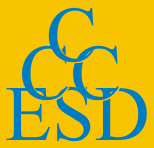As a result of an "Organizational meeting of Heads of Canadian Geology Departments" convened by W. Tupper,
at the 1974 GAC/MAC meetings in St. John's (quotes are from official documents or letters),
"A working committee of five representing the different geographic jurisdictions in Canada was
appointed." with W. M. Tupper as Chairman; the four regions were as they are now plus a chairman.
"Beer and sandwiches" were promised so attendance was good. Prior to that Ontario universities had formed
what is now the Council of University Departments of Geoscience in Ontario.
The first meeting of the Committee of Chairmen, Canadian Departments of Earth Science took place at Carleton University on 23/08/1974. Those present were
- Jacques Beland
- Laing Ferguson
- R. St. John Lambert
- David W. Strangway
- W. M. Tupper
The items discussed bear a remarkable similarity to more recent meetings, noting, amongst other things:
- The under-representation of the Solid Earth Sciences on the Allocation Committee of the
National Research Council (NRC); this produced a recommendation for direct
representation on the committee rather than through Engineering.
- The "division of monies between operating and equipment grants." needs examination
- "The need for more research monies in the Earth Sciences"
- The problem "that support for Canadian Research has been falling behind relative to other
countries on the World scene"
- That NRC "expenditures on research and development in Canadian universities is not
keeping pace with other facets of the Canadian economy."
- "a general need for more statistical information particularly on the number of students,
faculty members, technicians" etc.
- That "Each committee member is to collect this information for his geographic area by mid-November."
Thus was born the questionnaire.
The second meeting took place at the University of Ottawa on 19/10/1974. At this meeting the
committee decided to use the discipline breakdown used by CUDGO
and a document from their report pertaining to research and graduate instruction was circulated with
the minutes.
It is interesting to note that although the Minutes are headed Committee of Chairmen, throughout
the rest of the document they refer to themselves as "The Council". At the end of the document the
word Council is scratched out and Ex. Committee put in - but the handwriting looks like mine! This
ambivalence as to whether we were a Committee or a Council of Chairs continued for some years,
to judge by the headings for calls to meeting and reports. A Council in 1975. Neither in mid 1976.
A Committee again by the end of 1976. But by 1980 the term Council was firmly established. No doubt
this was due in part to the the practice of finding a new Chair every year. There was no set method
of electing/appointing members of the executive, so the business of Council and the process of data
collection and representation was fairly informal for the first few years. The Chair of the Council
became responsible for drawing up, printing and mailing the questionnaire and explanation sheet,
and for collecting, assembling and analysing the data; since the Chair changed each year there were
variations in how business and data collection was handled and numbers for the first few years are
even more unreliable than for the past few years (for more on this see History of the Questionnaire).
At the 1985 AGM in Fredericton a formal constitution was approved. The impetus for this was the
Geological Survey of Canada (GSC) which, as part of their manpower planning mandate for the solid
earth sciences, wanted to know what was in the pipeline which could match the expected national
and provincial needs and, if necessary by special grants, encourage interest in areas where there was
an expected deficiency; for collecting these data the GSC agreed to support the
Council financially but they could only give grants to organizations with a
formal constitution. The constitution provided for two year terms for the Chair
and an executive consisting of the chair and a representative from each of the
West, Quebec, Ontario and the Atlantic provinces; nevertheless, it was still
very much the responsibility of the Chair to handle all things pertaining to the
questionnaire leading to variations in what was sent out and in the method of analysing and
presenting the data.
The constitution was amended at the 1992 AGM where the objectives of Council were better
defined by Article I. 2. "To foster, coordinate, and promote education, training, and research in
earth sciences with particular emphasis on the needs, activities, and mandate of the earth science
departments in Canadian universities." The French equivalent of the title proposed by the Québec
provincial group Conférence des Directeurs de Départements Universitaire de Géologie du Québec
(CDDUGQ) was accepted and the acronym CCCESD/CDDGC or CDDGC/CCCESD adopted.
As part of its mandate the Council has taken the initiative on a number of occasions. One of the
earliest was the January 1981 workshop "Next decade of Earth Sciences in Canadian Universities"
at which the idea of LITHOPROBE was first formally suggested. Over a period of years there were
endless meetings about professional registration culminating in an Extraordinary General Meeting,
in 1985, where 22 attendees agreed unanimously (a result unheard of before - and probably since)
to an Official Position on the Licensing and Registration of Individual Geoscientists (see
Geolog
1986 v15 Part 4, pp.39-43 for the full document). Representations have been made to NSERC and
others about the withdrawal of support for universities in certain key areas of national interest (e.g.
loss of ship time on DFO ships). Other problems have to be tackled at the provincial level, such as
school curricula, but where there is not a provincial committee of Chairs the Council may write the
arguments.

